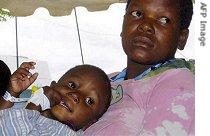2006年VOA标准英语-Report Shows Drop in Zimbabwe's AIDS Infection(在线收听)
By Peta Thornycroft
Harare
19 December 2006
In a year when Zimbabwe's economy continued to plummet and its death rate continued to soar, there was one piece of good news: the rate of infection of HIV/AIDS has dropped significantly. Peta Thornycroft reports that a new demographic survey, the first of its type to be done in Zimbabwe, has confirmed that Zimbabwe is the first southern African country to have reduced the numbers of people contracting HIV, the virus that causes AIDS.
It has been a terrible year for most Zimbabweans suffering under a collapsing economy and state repression.
 |
| A mother and child, both HIV positive at Parirenyatwa Hospital in Harare, (2005 file photo) |
Zimbabwe also has the highest rate of inflation at more than 1000 percent. It has the fastest shrinking economy in the world in a country that is not at war.
The rare good news is that Zimbabwe is the only country in southern Africa with a decreasing rate of infection of HIV/AIDS.
A group of international donors, which included the United States, funded the first Demographic Health Survey in Zimbabwe and the results were released earlier this month.
Zimbabwe's HIV infection rate among sexually active people has dropped to 18 percent, from a high the government says was over 30 percent.
A 65-year-old grandmother in Harare, who wishes to be known as Mary Mutasa, has lost three of her seven children, as well as three grandchildren, to HIV/AIDS. She is caring for two of her orphaned grandchildren, with help from compassionate employers.
Last year her home, along with thousands of others, was knocked down as part of a government-mandated campaign called Murambatsvina, or Clean-out-the-trash.
But amid all the hardships, she says there is one positive development. She has noticed that fewer young people are dying now in the working-class suburb where she lives than earlier in the decade.
"I know because at the location where I stay we had many, many funerals, now it's better, last time, now it is better... There are still funerals but it is not like last time, 2000, 2003, 2001, now in 2005 there were some but it is better," she said. "In 2006 its better than before when every time, every day there were three funerals, some next door, over there over there, there were many, many, many ... now it's better."
Her first child to die was 22 years old.
"Brian was the first person to have got AIDS, my son Brian," she said. "The man I was working with said, 'Ah, Brian is becoming thin, he is becoming thin.' I didn't know that it was AIDS, now he was getting thin and thin and he said; 'Mummy, my legs are weak.' He was a driver, he was young, he was about 20 years, he started to have girlfriends, many girlfriends, because he was a driver."
Christopher Dell, U.S. ambassador to Zimbabwe, says the demographic survey confirmed the lowering infection rate. Previously, HIV statistics were taken from pre-natal clinics and since many pregnant women can no longer afford to attend them, the data they provided became unreliable. Mr. Dell says the data for the latest survey were more accurate.
"We went around to almost 10,000 households, asked a lot of questions about health issues, not just HIV/AIDS, to establish a health baseline," he said. "Because it was so wide-ranging, and using modern research techniques we believe we have identified a real representative sample and for the first time we have solid evidence about the rate of prevalence of HIV/AIDS in Zimbabwe."
Earlier this month, United Nations envoy Stephen Lewis questioned whether Zimbabwe's infection rate was lowering. He speculated that the drop in HIV rates might be attributable to high mortality rates and the exodus of Zimbabweans.
But Dell believes the figures can be trusted. One of the reasons he does, he says, is that a significant numbers of Zimbabweans have changed their sexual behavior.
"There are two contributors to this, principally increased condom use, the highest uptake [use] of condom use in the world, is here in Zimbabwe, secondly young women are delaying the initiation of their sexual activity, avoiding some of the dangers that younger, less informed girls faced 10-15 years ago," he said.
Despite this good news, more than 3,000 young and often skilled people are dying every week in Zimbabwe from HIV/AIDS.
Even though there is almost universal awareness of the disease and how to prevent contracting it, the grandmother said people in her community still do not speak about the disease killing their children.
"You know people at the rural areas and at the location they don't like it known that they have AIDS," she said. "Some of them say someone gives them poison, but me, I know that it is AIDS."
But although Zimbabwe is making progress in the fight against HIV/AIDS, the country's ministry of health acknowledges much remains to be done. It say only 40,000 out of 300,000 people who need anti-retroviral drugs to keep the disease in check are currently receiving them. Health Minister David Parirenyatwa says he hopes Zimbabwe will provide free treatment for all those in need by 2010.